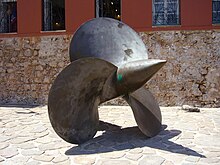
Back برونز مفسفر Arabic Bronze de fòsfor Catalan Fosforbronze Danish فسفر برنز Persian Bronze phosphoreux French リン青銅 Japanese Fosforinė bronza Lithuanian Fosforbrons Dutch Fosforbronse NB Fosfobrąz Polish

Phosphor bronze is a member of the family of copper alloys. It is composed of copper that is alloyed with 0.5–11% of tin and 0.01–0.35% phosphorus, and may contain other elements to confer specific properties (e.g. lead at 0.5–3.0% to form free-machining phosphor bronze). The tin increases the corrosion resistance and strength of the alloy, while the phosphorus increases its wear resistance and stiffness.[1]
Phosphor bronze alloys are notable for their toughness, strength, low coefficient of friction, and fine grain. The phosphorus reduces the viscosity of the molten alloy, which makes it easier and cleaner to cast and reduces grain boundaries between crystallites. It was originally formulated by the Belgian Georges Montefiore-Levi and the German Karl Künzel.[2][3]
- ^ Phosphor Bronze; Copper Development Association
- ^ "Jews in Belgium". Archived from the original on 6 February 2008.
- ^ JStR, No. 1,276, 1877, p. 551